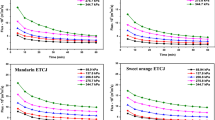Abstract
The sugar industry needs to find efficient methods in clarifying the raw sugarcane juice in order to improve the quality of the clarified juice and to reduce or eliminate the usage of chemicals (lime). Conventional clarifiers use heavy equipment which lead to high operating costs and associated environmental problems. In sugar mills, ensuring the production of juice of consistently high clarity and low colour through the clarification process is a challenging task. The variations in the incoming juice characteristics due to differences in cane variety, soil and growing conditions, weather patterns and season make this task even more challenging. Membrane filtration promises superior quality juice with better clarity, much lower viscosity and noticeable colour removal. Ultrafiltration of clarified sugarcane juice can be done through spiral wound or flat sheet filtration systems using polymeric membranes or tubular filtration systems using ceramic membranes. This review evaluates the applications of membrane technology in sugar industry all over the world and the need for it in the Australian sugar industry. This is an important first step to identify the appropriate types and applications of membranes.









Similar content being viewed by others
References
Balakrishnan M, Dua M, Bhagat JJ (2000) Evaluation of ultrafiltration for juice purification in plantation white sugar manufacture. Int Sugar J 1213:21–24
Balakrishnan M, Dua M, Khairnar PN (2001) Significance of membrane type and feed stream in the ultrafiltration of sugarcane juice. Sep Sci Technol 36(4):619–637
Bhattacharya PK, Agarwal S, De S, Rama Gopal UVS (2001) Ultrafiltration of sugar cane juice for recovery of sugar: analysis of flux and retention. Sep Purif Technol 21(3):247–259
Carrizo de Bellone S, Bellone C (2006) Presence of endophytic diazotrophs in sugarcane juice. World J Microbiol Biotechnol 22(10):1065–1068
Cartier S, Theoleyre M, Lancrenon X, Decloux M (1996) Membrane technology in the sugar industry. In: Proceedings of SPRI workshop on separation processes in the sugar industry, New Orleans, Louisiana, USA, October 1996, pp 55–68
Chung CC (2000) Handbook of sugar refining: a manual for the design and operation of sugar refining facilities. John Wiley & Sons, Inc., New York, p 768
Clarke SJ (2003) Some hard lessons with membrane filtration. In: Proceedings of the sugar industry technologist symposium, Australia
Ghosh AM, Balakrishnan M (2003) Pilot demonstration of sugarcane juice ultrafiltration in an Indian sugar factory. J Food Eng 58(2):143–150
Ghosh AM, Balakrishnan M, Dua M, Bhagat JJ (2000) Ultrafiltration of sugarcane juice with spiral wound modules: on-site pilot trials. J Membr Sci 174(2):205–216
Gyura J, Seres Z, Vatai G, Molnár EB (2002) Separation of non-sucrose compounds from the syrup of sugar-beet processing by ultra- and nanofiltration using polymer membranes. Desalination 148(1–3):49–56
Hamachi M, Gupta BB, Ben Aim R (2003) Ultrafiltration: a means for decolorization of cane sugar solution. Sep Purif Technol 30(3):229–239
ICUMSA (1994) ICUMSA (International Commission for Uniform Methods of Sugar Analysis) methods book. ICUMSA Publications, British Sugar Centre, Colney
Jacob S, Jaffrin MY (2000) Purification of brown cane sugar solutions by ultrafiltration with ceramic membranes: investigation of membrane fouling. Sep Sci Technol 35(7):989–1010
Kishihara S, Fujii S, Komoto M (1981) Ultrafiltration of cane juice; influence of flux and quality of permeate. Int Sugar J 83(986):35–39
Kishihara S, Tamaki H, Fujii S, Komoto M (1989) Clarification of technical sugar solutions through a dynamic membrane formed on a porous ceramic tube. J Membr Sci 41:103–114
Kwok RJ (1996) Production of super VLC raw sugar in Hawaii. Experience with the new NAP ultrafiltration/softening process. Int Sugar J 98(1173): 490–492 (494, 496)
Lingle SE, Wiegand CL (1997) Soil salinity and sugarcane juice quality. Field Crops Res 54(2–3):259–268
Lingle SE, Wiedenfeld RP, Irvine JE (2000) Sugarcane response to saline irrigation water. J Plant Nutr 23(4):469–486
Mao LC, Xu YQ, Que F (2007) Maintaining the quality of sugarcane juice with blanching and ascorbic acid. Food Chem 104(2):740–745
Nene SN, Karode SK, Courtois T, Mietton-Peuchot M, Gupta BB, Ben-Aim R (2000) Filtration of raw cane sugar solutions with ceramic membranes. In: The 8th world filtration conference 3–7 April 2000, Brighton, UK
Nielsen WK, Kristensen S, Madsen RF (1982) Prospects and possibilities in application of membrane filtration systems within the beet and cane sugar industry. Sugar Technol Rev 9:59
Saha NK, Balakrishnan M, Ulbricht M (2006) Polymeric membrane fouling in sugarcane juice ultrafiltration: role of juice polysaccharides. Desalination 189(1–3):59–70
Saroha M, Singh H (1979) Effect of prevention of iron chlorosis on the quality of sugarcane grown on vertisols. Plant Soil 52(4):467–473
Saska M, McArdle J, Eringis A (1999) Filtration of clarified cane juice using spiral polymeric membrane configuration. Proc Int Soc Sugarcane Technol 23:17–23
Steindl RJ (2001) Membrane filtration technology in the cane sugar industry. Proc Int Soc Sugar Cane Technol, 3–10
Steindl RJ, Rackemann DW (2010) Membrane filtration of clarified juice. In: Proceedings of the 27th international society of sugar cane technologists congress, 7–11 March 2010, Veracruz, Mexico
Verma SK, Srikanth R, Das SK, Venkidachalam G (1996) An efficient and novel approach for clarification of sugarcane juice by micro-and ultrafiltration methods. Indian J Chem Technol 3(3):136–139
Wiedenfeld B (2008) Effects of irrigation water salinity and electrostatic water treatment for sugarcane production. Agric Water Manag 95(1):85–88
Willet CC (1997) The A.B.C. process. Direct production of refined quality sugar from cane mixed juice. Int Sugar J 99(1177E):7
Yadav DV, Singh K (1988) Lime-induced iron chlorosis in sugarcane. Nutr Cycl Agroecosyst 16(2):119–136
Acknowledgments
Sugar Research and Development Corporation funded a project entitled “JCU029: evaluation of membrane technology for clarification of sugarcane juice (2007–2009)” to carry out this work. The authors would also like to acknowledge Professor Rod Steindl for his kind permission to reuse tables and figures from his paper.
Author information
Authors and Affiliations
Corresponding author
Rights and permissions
About this article
Cite this article
Jegatheesan, V., Shu, L., Keir, G. et al. Evaluating membrane technology for clarification of sugarcane juice. Rev Environ Sci Biotechnol 11, 109–124 (2012). https://doi.org/10.1007/s11157-012-9271-1
Published:
Issue Date:
DOI: https://doi.org/10.1007/s11157-012-9271-1




